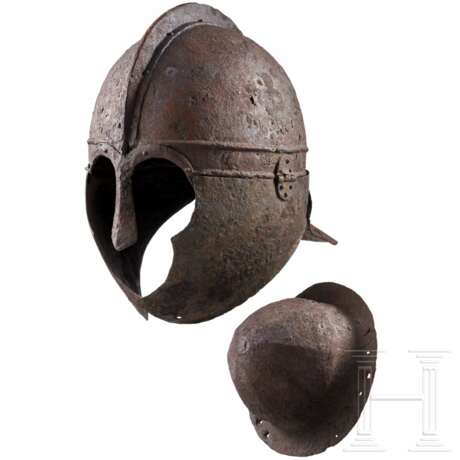Spätrömischer, zweischaliger Kammhelm aus Eisen, 4. Jhdt. n. Chr., dazu ein zeitgleicher Schildbuckel
10.10.2023 10:00UTC +01:00
Classic
Vendu
25000EUR € 25 000
| Auctioneer | Hermann Historica |
|---|---|
| Lieu de l'événement | Allemagne, Grasbrunn / München |
| Commission | 25 % |
Archive
La vente aux enchères est terminée. Vous ne pouvez plus enchérir.

ID 1033526
Lot 13 | Spätrömischer, zweischaliger Kammhelm aus Eisen, 4. Jhdt. n. Chr., dazu ein zeitgleicher Schildbuckel
Valeur estimée
€ 25 000
Selten erhältliches Exemplar aus der Gruppe spätrömischer Kammhelme, die die Tradition früh- und mittelkaiserzeitlicher Helme, deren Kalotten aus einem Stück getrieben waren, brachen. Typisch für spätrömische Helme waren diese nun vielteilig konstruiert.
Dazu ein wohl ursprünglich zum gleichen Komplex gehöriger Schildbuckel in auffallend ähnlichem Erhaltungszustand. Oberer, annähernd halbkugeliger Teil achtfach facettiert, darunter nach innen eingezogen. Der fast rechtwinklig abstehende, kreisförmige Rand von 2,5 cm Breite mit drei Paaren von quadratischen Nietlöchern durchstoßen. Durchmesser 15,5 cm. Höhe 9 cm.
Provenienz: Aus dem Nachlass eines süddeutschen Militaria-Sammlers, erworben 2010 bei Hermann Historica in Auktion 59, Los 67. Zuvor Privatsammlung USA, erworben in den 1980er Jahren. Publiziert und ausgestellt in "Attila und die Hunnen", Historisches Museum der Pfalz, Speyer 2007, Katalog S. 250 f. Zuletzt ausführlich abgebildet und besprochen in Miks, Christian, "Ein spätrömischer Depotfund aus Koblenz am Rhein. Studien zu den Kammhelmen der späten Kaiserzeit", 2014, S. 231 und Taf. 119 - 121. Dort weitere Literatur mit Erwähnung des Helms aufgeführt.
A Late Roman helmet of iron with bipartite bowl and ridge, 4th century A.D., with a shield boss of the same period
Late Roman helmet of the Deurne/Berkasovo type with the typical wide cheek flap (sometimes attributed to cavalry, not certain). The calotte consists of two shells, the lower part has two horizontal, narrow ribs forged out from the inside. In front two cutouts above the eyes. Connected in the centre by a hollow forged ridge with eight rivets driven through the ridge and edge of the calotte halves on each side. Above the cutouts for the eyes, a nasal with a central bend and lateral, solid arches with a central ridge. Two rivets are driven through each of these arches, which additionally connect the bowl halves at the forehead. The cheek flaps are connected on the outside by a hinge with a three-part joint and semicircular fittings on both sides with three rivets each. The underside of the cheek flaps slightly flared at the edge and curved in an S-shape, extended deeper towards the bottom, with two arched cutouts at the front. A hole for lacing in the front angle. The neck guard, projecting outwards after a bend at the back, is also connected to the calotte by a similar hinge, but with a trapezoidal fitting at the top. The right cheek flap replaced in the middle and lower part, as well as the tip of the nasal. Otherwise conservatively treated, very good original condition. Length from nasal to neck guard 30 cm. Height from the lower edge of the cheek flaps to the crest 30 cm. Width 18 cm.
Rarely available example from the group of Late Roman crest helmets that broke with the tradition of Early and Middle Imperial helmets whose bowls were hammered from a single piece. Typical of late Roman helmets, this one was now constructed in many pieces.
In addition, a shield boss that probably originally belonged to the same complex in a remarkably similar state of preservation. The upper, almost hemispherical part is eight-fold faceted, the lower part is inwardly recessed. The circular rim of 2.5 cm width protruding almost at right angles is pierced with three pairs of square rivet holes. Diameter 15.5 cm. Height 9 cm.
Provenance: From the estate of a South German militaria collector, acquired in 2010 at Hermann Historica in auction 59, lot 67. Previously private collection USA, acquired in the 1980s. Published and exhibited in "Attila and the Huns", Historisches Museum der Pfalz, Speyer 2007, catalogue p. 250 f. Last illustrated and reviewed in Miks, Christian, "Ein spätrömischer Depotfund aus Koblenz am Rhein. Studien zu den Kammhelmen der späten Kaiserzeit", 2014, p. 231 and plates 119 - 121. Further literature with mention of the helmet listed there.
Condition: II
| Lieu d'origine: | Empire romain |
|---|
| Lieu d'origine: | Empire romain |
|---|
| Adresse de l'enchère |
Hermann Historica Bretonischer Ring 3 85630 Grasbrunn / München Allemagne | ||||||||||||||
|---|---|---|---|---|---|---|---|---|---|---|---|---|---|---|---|
| Aperçu |
| ||||||||||||||
| Téléphone | +49 (0)89 5472 649 0 | ||||||||||||||
| Fax | +49 (0)89 5472 64999 | ||||||||||||||
| Commission | 25 % | ||||||||||||||
| Conditions d'utilisation | Conditions d'utilisation | ||||||||||||||
| Heures d'ouverture | Heures d'ouverture
|


